Complete Solutions to MCQS of chapter GENERAL PRINCIPLES AND PROCESSES OF ISOLATION OF ELEMENTS of Class 12 book with complete answers and questions
| Class 12 | CHEMISTRY |
| Chapter | GENERAL PRINCIPLES AND PROCESSES OF ISOLATION OF ELEMENTS |
| NCERT FINGERTIPS | MCQS |
| Number Of Questions | 96 |
| Academic Year | 2023-24 |
Which of the following examples is not correctly matched ?
02:25View SolutionWhich of the following is not the correct name of the formula of the ore given with it ?
02:03View SolutionIn which of the following the name of the ore is not matched with its formula ?
01:24View SolutionPyrolusite is
00:46View SolutionThe metal which can be extracted from the bauxite ore is:
02:03View SolutionWhich of the following is magnetite ?
00:50View SolutionWhich of the following is not an ore of magnesium?
02:28View SolutionWhich of the following is not an ore?
01:47View SolutionWhich one of the following is not a sulphide ore ?
02:11View SolutionAn example of halide ore is
01:23View SolutionWhich of the following is not a carbonate ore?
01:25View SolutionFind the incorrect match.
02:22View SolutionRemoval of the unwanted materials from the ore is known as
01:27View SolutionThe powdered ore is agitated with water or washed with running stream of water. The heavy ore particles and lighter impurities are separated . This method of concentration is known as
02:44View SolutionWhich one of the following scrap metal cannot be separated by magnetic separation ?
02:29View SolutionAn ore of tin containing `FeCrO_(4)` is concentrated by _____.
06:55View SolutionSulphide ore of copper can be concentrated by
02:51View SolutionFor which ore of the metal, froth floatation method is used for concentration?
01:07View SolutionWhich of the following statements is correct about the role of substances addedd in the froth floatation process?
03:32View SolutionFroth floatation process isused to concentrate:
02:06View SolutionOil used as frothing agent in froth-floatation process is
01:12View SolutionHow do we separate two sulphide ores by froth floatation method?
View SolutionSometimes, it is possible to separate two sulphide ores by adjusting proportion of oil to water or by using depressants. In case of an ore containing ZnS and PbS, the depresent used is
02:34View Solutionthe common impurities present in bauxite are
01:11View SolutionWhich of the following reactions does not take place during leaching for concentration of bauxite ?
04:04View SolutionThe signifificance of leaching in the extraction of aluminume is
01:51View SolutionWhich one of the following ores is treated by chemical leaching
01:40View SolutionWhich of the following metals is not extracted by leaching ?
01:37View SolutionHow is leaching carried out in case of low grade copper ores?
01:42View SolutionWhich of the following changes take place during roasting ?
(i) Impurities are removed as they form volatile oxides.
(ii) Ore is converted into their volatile oxides.
(iii) Changes like oxidation , chlorination, etc. take place02:27View SolutionHeating pyrites to remove sulphur is called
01:51View SolutionWhich of the following is not an example of roasting ?
02:10View SolutionFill in the blanks with the correct choice.
The undesired impurities present in the ores are called `overset((i))("______")` . To remove the volatile impurities from the ore, the `overset((ii))("______")` process is carried ot Flux combines with non-fusible impurities to form `overset((iii))("______")`. CaO acts as a `overset((iv))("______")`flux.01:44View SolutionHow mant reaction can show slag formation process from the given reaction ?
(i) `SiO_(2) + CaO rarr CaSiO_(3)`
(ii) `FeO + SiO_(2) rarr FeSiO_(3)`
(iii) `CaO + P_(2)O_(5) rarr Ca_(3)(PO_(4))_(2)`
(iv) `Cr_(2)O_(3) + 2Al rarr Al_(2)O_(3) + 2Cr`
(v) `MgCO_(3) + SiO_(2) rarr MgSiO_(3) + CO_(2)`.02:36View SolutionExplain the following
`(i)` Chalcocite is roasted and not calcined during recovery of copper.
`(ii)` Magnesium oxide is used for lining in steel making furnace03:58View SolutionWhich of the following metals is extracted using silica lined convertor ?
02:34View SolutionWrought iron is the purest form of iron. Write a reation used for the preparation of wrought iron from cast iron. How can the impurities of sulphur, silicon and phosphorus be removed from cast iron?
07:41View SolutionWhich of the following reactions show the process of smelting ?
01:50View SolutionWhich of the following sulphides when heated without undergoing separated reduction of oxide ?
02:03View SolutionMatch the column I with Column II and mark the appropriate choice.
 01:49View Solution
01:49View SolutionEllingham diagram represents:
01:12View SolutionWhich of the following statements is correct according to the basic concepts of thermodynamics which govern the feasibility of a metallurgical process ?
03:08View SolutionWhy are sulphide ores converted to oxide before reduction?
01:34View SolutionThe metal oxide reacts with a ________ . The oxides is _______ to metal and reducing agent is ________ . Net Gibbs energy change is ___________ .
02:43View Solution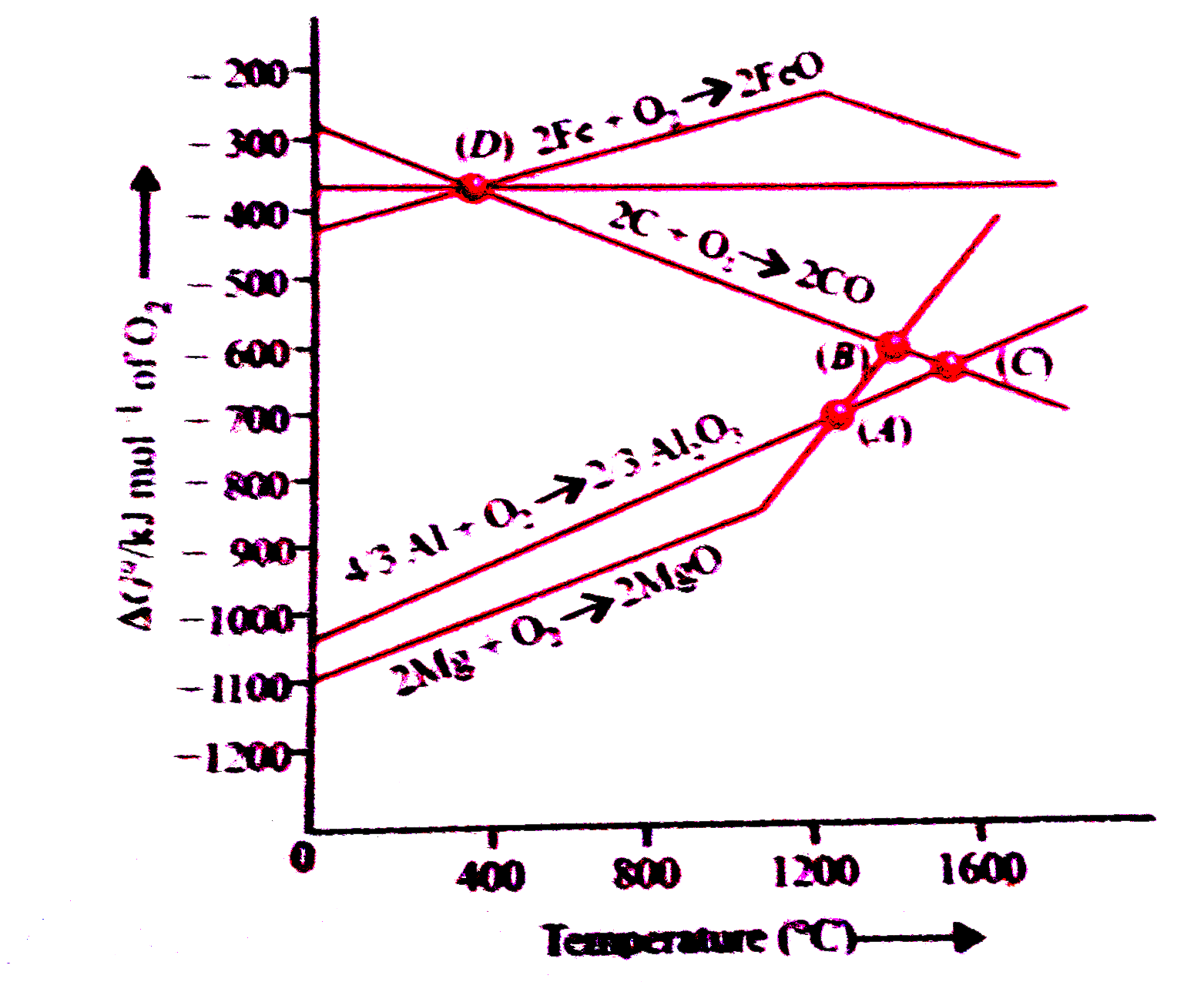
At the points of intersection of `Al_(2)O_(3)` and MgO curves (A), `DeltaG^(@)` becomes zero for reaction,
`(2)/(3)Al_(2)O_(3) + 2Mg to 2MgO + 4/3 Al`
Above this point, magnesium can reduce alumina. Although thermodynamically feasible, Mg is not used to reduction of `Al_(2)O_(3)` because02:19View Solution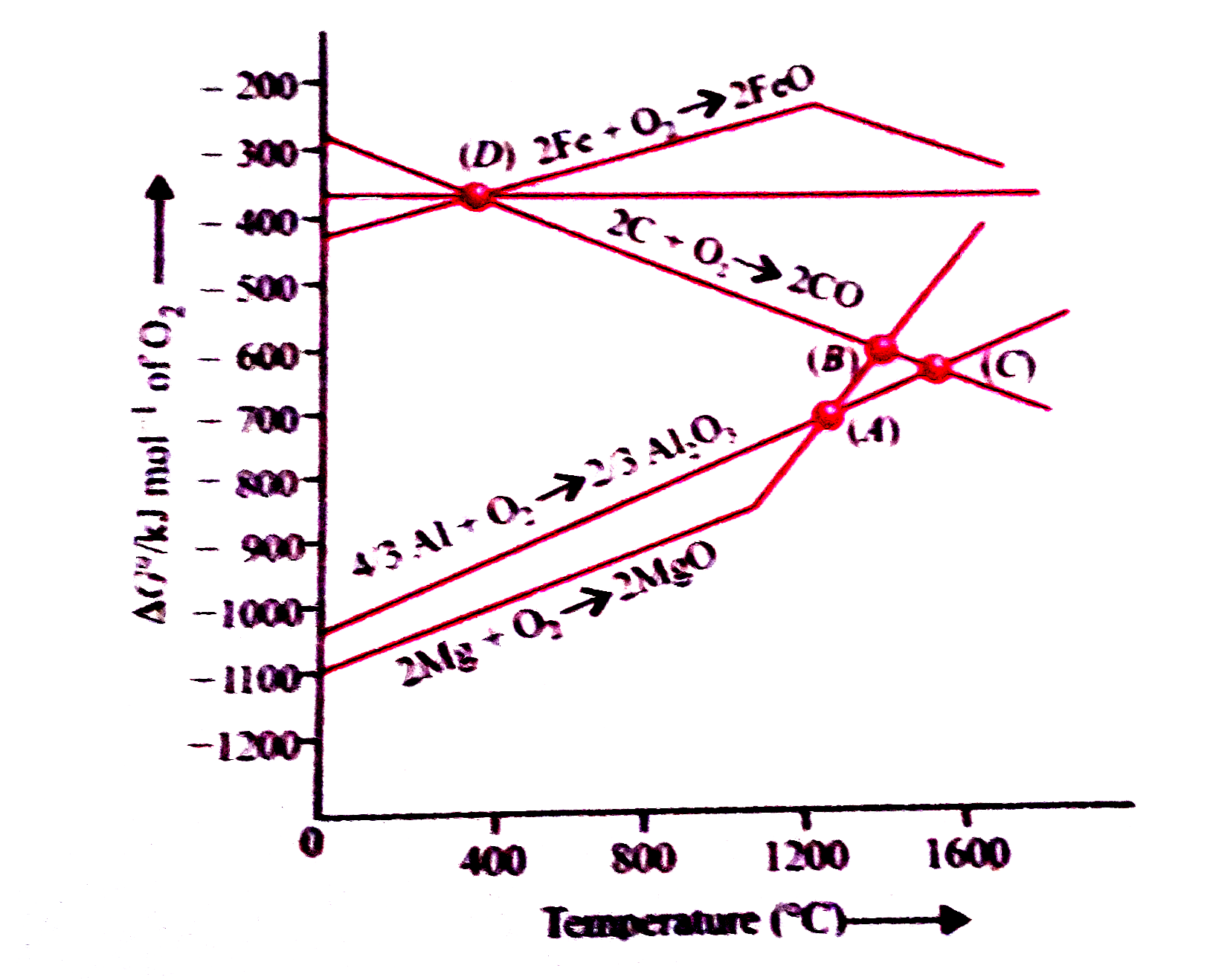
For the reduction of FeO with C at the temperature corresponding to (D) , which of the following statements is correct ?03:52View SolutionWhich of the following is not correct observation on Ellingham diagram ?
02:38View SolutionWrite down the reactions taking place in Blast furnace related to the metallurgy of iron in the temperature range `500-800K`
01:37View SolutionWhich of the following reactions takes place at higher temperature range (900 K-1500 K) in blast furnace ?
01:47View SolutionIn the manufacture of iron from hematite, limestone is added to act as _____.
02:06View SolutionThe main reactions occuring in blast furnace during extraction of iron from haematite ore…..
03:59View SolutionThe materials which can withstand very high temperature without melting or becoming soft are called……………….. . These are used in making …………….of furnaces.
02:10View SolutionHow is cast iron different from pig iron ?
02:26View SolutionImpurities present in wrought iron ?
01:51View SolutionIn blast furnace, iron oxide is reduced by
02:40View SolutionBlister copper obtained during extraction from cuprous oxide is called so because
02:45View SolutionWhy partial roasting of sulphide ore is done in the metallurgy of copper ?
02:44View SolutionSilica is added to the sulphide ore of copper in reverberatory furnace because
02:20View SolutionBlister copper is
03:17View SolutionFrom the Ellingham graph between Gibbs energy and temperature , out of C and CO which is a better reducing agent for ZnO ?
04:35View SolutionThe reaction
`Cr_2O_3+2AltoAl_2O_3+2Cr` `(triangleG^(ɵ)=-421kJ))`
Is thermodynamically feasible as is apparent from the Gibbs energy value. Why does it not take place at room temperature?05:05View SolutionIn the thermite process, _____is used as a reducting agent.
05:55View SolutionThe metallurgical process in which a metal is obtained in a fused state is called
02:56View SolutionThe metal that cannot be produced on reduction of its oxide by aluminium is :-
02:14View SolutionMark the incorrect statement.
02:35View SolutionMatch the column I with Column II to match the method of extraction and mark the appropriate choice.
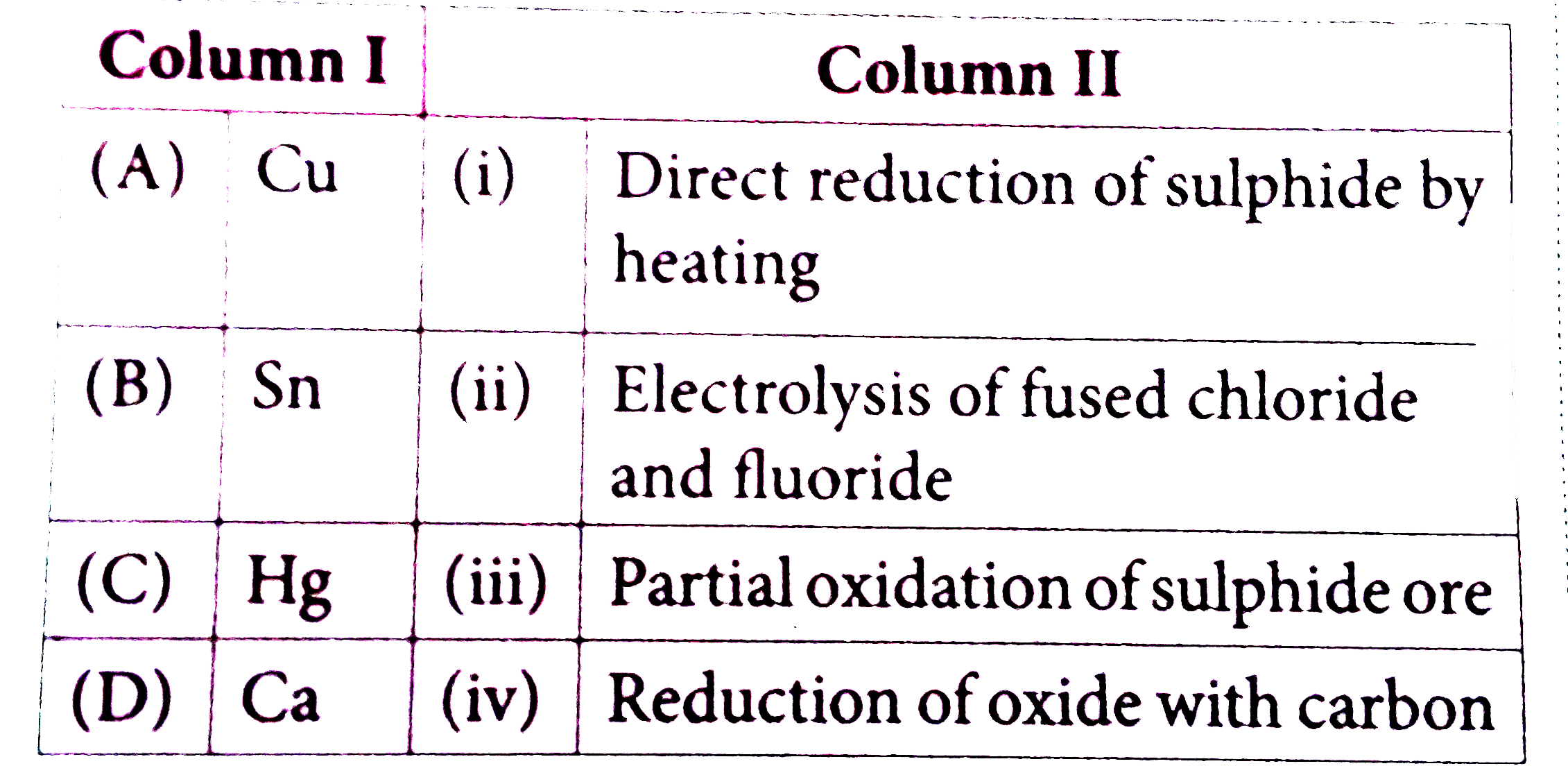 06:08View Solution
06:08View SolutionWhich of the following metals are extracted by electrolytic reduction?
04:31View SolutionWrite chemical reactions taking place in the extracion of Aluminium from Bauxite ore .
03:06View SolutionCuyolite and fluorspar are mixed with `Al_(2)O_(3)` during electrolysis for extraction of aluminium to
02:25View SolutionIn electrometallury of aluminium , what will happen if graphite rodes are not used as anode and are replaced by some other metal ?
02:27View SolutionOut of the following matals that cannot be obtained by electrolysis of the aquenous solution of their salts is
05:25View SolutionWhich of the following statements is correct ?
(i) Copper is extracted by hydrometallury from low grade ores.
(ii) In electrolytic reduction of alumina , graphite is acting as anode and steel vessel with lining of carbon acts as cathode.
(iii) In Hall-Heroult process, aluminium is obtained at anode and CO and `CO_(2)` are produce at cathode03:57View SolutionIn the extraction of chlorine from brine_________
02:22View SolutionFollowing reactions take place during extraction of gold
`4Au+8CN^(-)+ 2H_(2)O + O_(2) to 4[Au(CN)_(2)]^(-)+ 4OH^(-)`
`2[Au(CN)_(2)]^(-) + Zn to 2Au + [Zn(CN)_(4)]^(2-)`
Zinc in the extraction of gold acts as a/an01:02View SolutionAluminium metal is generally used for the extraction of chromium and manganese from their oxide ores. Explain.
02:15View SolutionWhich of the following is not a refining process?
01:37View SolutionIn this method, a low melting metal like tin can be made to flow on a sloping surface. In this way it is separated from higher melting impurities . This method is known as
01:30View SolutionMost electropositive metal are obtained from their ores by
04:46View SolutionWhich one of the following is true in electrolytic refining ?
02:28View SolutionCarnallite on electrolysis gives
01:36View SolutionIn electrorefining of copper,some gold is deposited as
01:49View SolutionDuring the process of electrolytic refining of copper some metals present as impurity settle as 'anode mud'. These are
02:03View SolutionWhich of the following is used as a method purification for silicon ?
01:08View SolutionWhich of the follwing are main requirements for vapour phase refining ?
(i) Metal should form a volatile compound with the reagent
(ii) The volatile compound should be easily decompsoable to give back pure metal
(iii)Metal should be very reactive and form a stable compound with the reagent03:47View Solution(xiv) Following equation represents a method of purification of nickel by
`underset ("Impure")(Ni) + 4CO overset (320 K)rarr Ni(CO)_(4) overset(420 K)rarr underset("Pure") (NO) + 4CO`.02:10View SolutionWhich method of purification is represented by the following equations
`Ti +2I_(2) overset(523K)rarr TiI_(4) overset(1700K)rarr Ti +2I_(2)`01:05View SolutionColumn chromatography involves separation of a mixture over a column of adsorbent (stationary phase) packed in a glass tube. Depending upon the degree of adsorption complete separation takes places . In the given column, three coloured bands x, y, z are formed . Identify the correct statement .
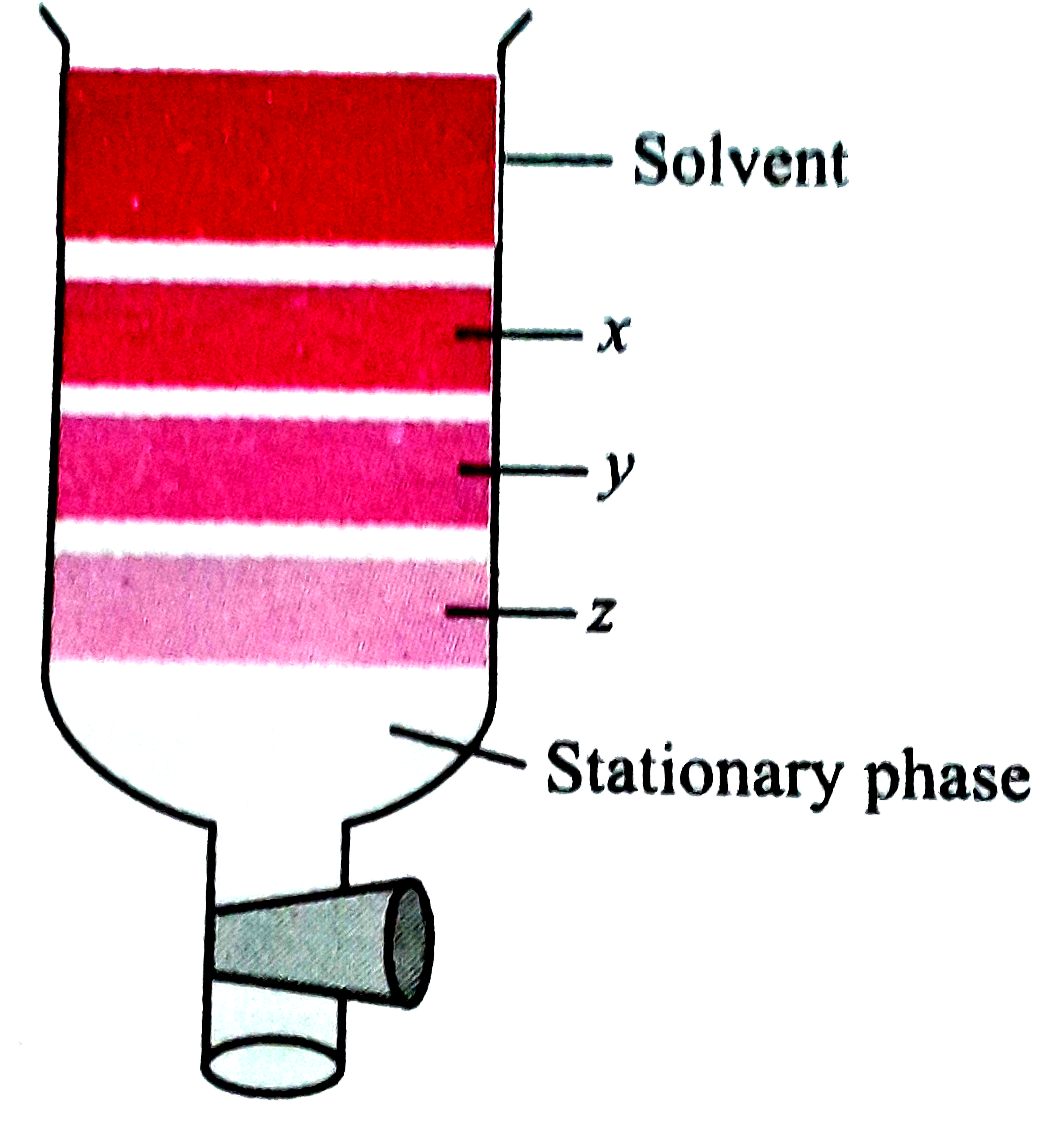 02:31View Solution
02:31View SolutionDuring a column chromatography through `Al_(2)O_(3)` column, a mixture of components A,B and C is passed through the column. On adding eluant, compound 'A' is eluted first then 'B' and in the end 'C'. Which of the following statements regarding the components is correct ?
02:02View SolutionChromatography is used for the purification of
01:30View SolutionThe mineral carnallite contains (i)("__________"") and (ii)("__________"") metals.
(iii)("__________"") is purified by cupellation and (iv)("__________"") is purified by distillation .01:42View SolutionMark the correct statements.
(i) Mercury can be refined by the process of distillation.
(ii) In poling, the molten impure metal is stirred with green poles of wood.
(iii) In electrolytic refining of metals , impure metal is made as cathode and a thin strip of pure metal is made as anode.04:32View SolutionMatch the column I with Column II and mark the appropriate choice.
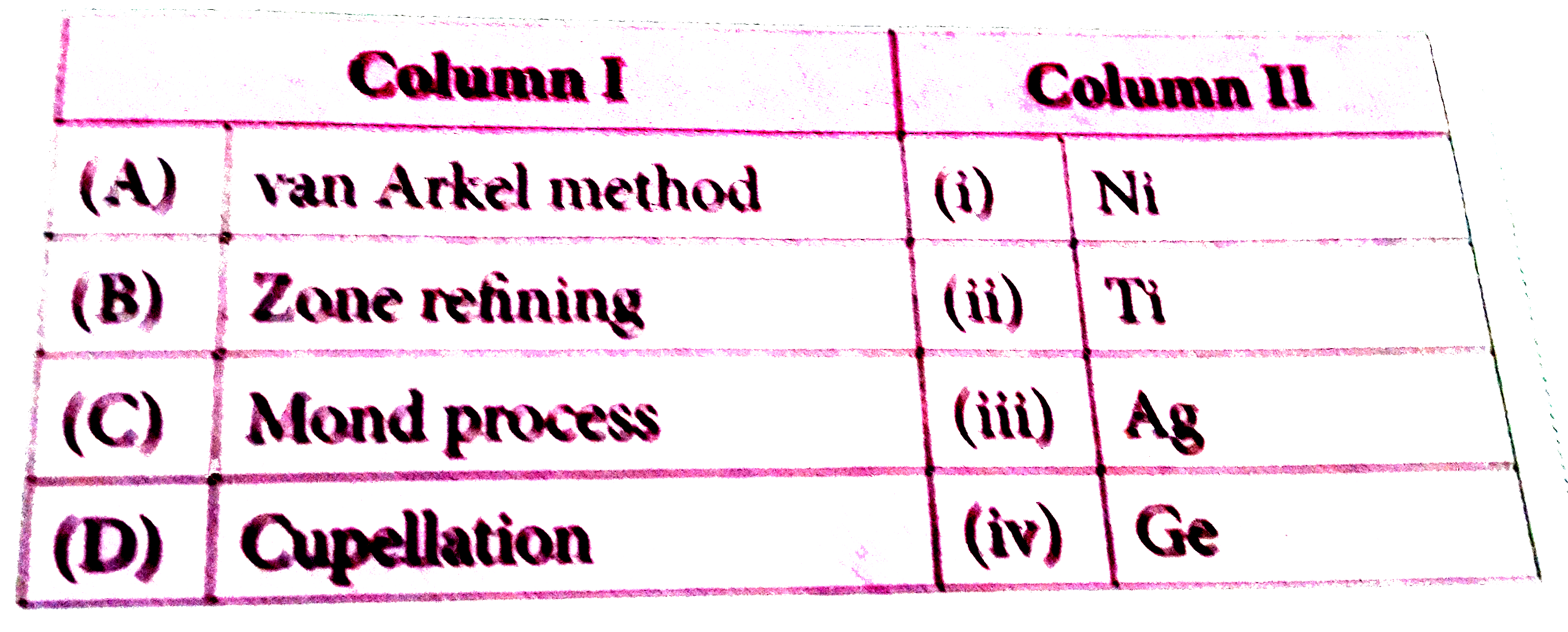 03:00View Solution
03:00View SolutionWhich of the following statements is not correct ?
01:56View SolutionFind the incorrect match.
01:56View Solution___________ and ________ are alloys of copper.
00:53View SolutionMatch the column I with Column II and mark the appropriate choice.
 01:51View Solution
01:51View Solution
MCQS questions and complete solutions for chapter GENERAL PRINCIPLES AND PROCESSES OF ISOLATION OF ELEMENTS of MTG CHEMISTRY (ENGLISH) of Class 12
All Exercises from NCERT FINGERTIPS Class 12 CHEMISTRY GENERAL PRINCIPLES AND PROCESSES OF ISOLATION OF ELEMENTS
- ASSERTION & REASON
- Assertion And Reason
- Concentration Of Ores
- Electrochemical Principle Of Metallurgy
- Extraction Of Crude Metal From Concentrated Ore
- Higher Order Thinking Skills
- HOTS
- MCQS
- NCERT Exemplar
- NCERT EXEMPLAR PROBLEMS
- Occurrence Of Metals
- Oxidation Reaction
- Refining
- Thermodynamic Principle Of Metallurgy
- Uses Of Aluminium,Copper,Zinc And Iron
